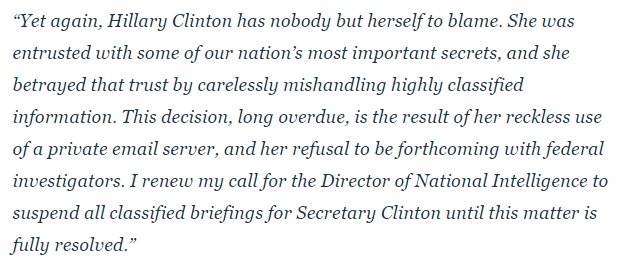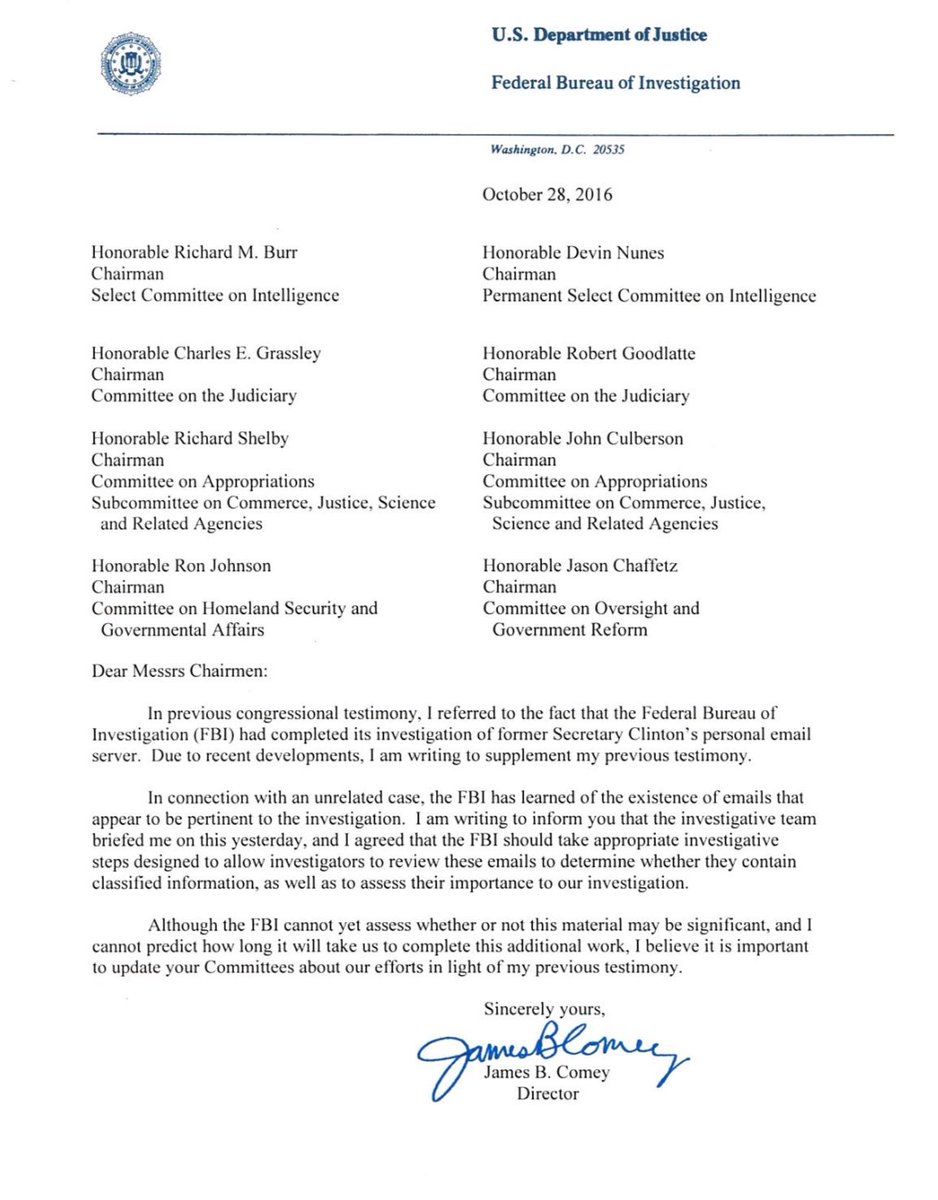Update: There are countless investigations ongoing and as it relates to this reopen of the Hillary case:
New emails found on a government official’s device, likely Huma Abedin tied to the FBI’s Clinton inquiry were discovered during the investigation into Anthony Weiner’s sexting.
It appears there are countless emails coming into evidence that are the cause of the House Oversight Committee and the FBI may be re-opening the email/server investigation. Given the handful of days remaining before the general presidential election, it is assured that something significant has come to the surface that would approve this decision.
Speaker Paul Ryan has just called for cancelling all security briefings for Hillary Clinton.
Jason Chaffetz@jasoninthehouse
FBI Dir just informed me, “The FBI has learned of the existence of emails that appear to be pertinent to the investigation.” Case reopened.
Back in September:
Smith Calls for FBI to Reopen Clinton Investigation
Sep 28, 2016Press ReleaseWASHINGTON – U.S. Rep. Lamar Smith (R-Texas), chairman of the U.S. House Science, Space, and Technology Committee, today urged FBI Director James Comey to reopen the FBI’s investigation of former Secretary of State Hillary Clinton’s private email server.
At today’s House Judiciary Committee hearing titled Oversight of the Federal Bureau of Investigation, Rep. Smith questioned Director Comey and described several recent developments that would justify a reopening of the investigation, including:
- Reports that an employee at a company that managed former Secretary Clinton’s private email server said on the forum Reddit.com, “ . . . I need to strip out a VIP’s (VERY VIP) email address from a bunch of archived emails….” This same employee called a new retention policy designed to delete emails after 60 days a “Hillary cover-up operation.”
- A former Clinton Foundation employee who also managed the Clinton server destroyed devices used by Clinton by smashing them with a hammer.
- Two employees involved in maintaining the Clinton server recently pleading the Fifth Amendment to Congress to avoid self-incrimination.
Rep. Smith also urged Director Comey to ensure that the FBI complied with the Science Committee’s recent subpoena of documents related to the server. More here.
****
Related reading: House Oversight Chairman promises years of Clinton investigations: ‘She’s not getting a clean slate’
We don’t know if another whistleblower has come forward or if the WikiLeaks emails are at the center of the decision to re-open the Hillary servergate issue but the letter signed by James Comey does offer some clues.
****
BusinessInsider: NBC News also reported that the FBI will reopen its investigation. In a letter to Congress, FBI director James Comey wrote that the investigative team in charge of looking into Clinton’s server briefed him on Thursday on new emails they found that might contain classified information.
“The FBI cannot assess whether or not this material may be significant,” Comey wrote.
****NYPost: For months now, we’ve been told that Hillary Clinton’s 33,000 missing emails were permanently erased and destroyed beyond recovery. But newly released FBI notes strongly suggest they still exist in several locations — and they could be recovered, if only someone would impanel a grand jury and seize them.
In a May interview with FBI agents, an executive with the Denver contractor that maintained Clinton’s private server revealed that an underling didn’t bleach-clean all her subpoenaed emails, just ones he stored in a data file he used to transfer the emails from the server to Clinton’s aides, who in turn sorted them for delivery to Congress.
The Platte River Networks executive, whose name was redacted from the interview report, said PRN tech Paul Combetta “created a ‘vehicle’ to transfer email files from the live mailboxes of [Clinton Executive Services Corp.] email accounts [and] then later used BleachBit software to shred the ‘vehicle,’ but the email content still existed in the live email accounts.”
Unless one of Clinton’s aides had the capability to log in to the PRN server as an administrator and remove a mailbox, her archived mailboxes more than likely still reside somewhere in that system. And they may also materialize on an internal “shared drive” that PRN created to control access to the Clinton email accounts among PRN employees. PRN has been under FBI order to preserve all emails and other evidence since the start of its investigation last year.
Clinton’s missing “personal” emails may also be captured on a Google server. According to FBI notes, Combetta “transferred all of the Clinton email content to a personal Google email address he created.” Only the FBI never subpoenaed Google to find out.
The FBI documents also reveal that Hillary’s server was mirrored on a cloud server in Pennsylvania maintained by Datto Inc., a tech firm that performs cloud-to-cloud data protection.
When PRN contracted with Datto, it requested that Hillary’s server be backed up locally and privately. But the techs forgot to order the private node, and they sent the server backup data “remotely to Datto’s secure cloud and not to a local private node.” The FBI never subpoenaed Datto’s server, either.
Then there’s the laptop Combetta loaded with the Clinton email archive and allegedly shipped back to a Clinton aide in Washington, who claims it got “lost” in the mail. Not so fast: The latest FBI document dump includes a series of interviews with an unidentified former “special assistant” to Clinton at the State Department who said the elusive Apple MacBook laptop was actually “shipped to the Clinton Foundation in New York City.”
But in a June follow-up interview, FBI agents inexplicably left it up to this critical witness to “inquire about the shipment” with the foundation’s mailroom manager, who works in Rockefeller Center. The FBI still does not have the laptop in its possession.
It turns out that investigators also know the whereabouts of the original Apple server Clinton used in her first two months in office. Recovering that equipment is critical because it contains a mass of unseen emails from Jan. 21, 2009, to March 18, 2009 — a critical period in Clinton’s tenure at State. Witnesses say the equipment was not discarded, as first believed, but “repurposed” as a “work station” used by staff in Clinton’s Chappaqua residence.
Yet the FBI says it “was unable to obtain the original Apple server for a forensic review.” Instead of seizing it, the agency has taken Clinton’s aides’ and lawyers’ word that the server’s bereft of relevant emails. In fact, the agency confesses on Page 27 of its 47-page investigative case summary that it failed to recover other equipment and data as well: “The FBI’s inability to recover all server equipment and the lack of complete server log data for the relevant time period limited the FBI’s forensic analysis of the server systems. As a result, FBI cyber analysis relied, in large part, on witness statements.”
Congressional investigators say FBI Director James Comey in his year-long “investigation” didn’t even bother to send agents to search Clinton’s homes in Chappaqua or Washington, DC. Nor did he dispatch them to the offices of the Clinton Foundation or Clinton Executive Services Corp. in New York City.
“The Clinton residences and other locations should have been treated like any other criminal investigation — with federal grand jury subpoenas or search warrants issued by judges and served in the middle of the night,” said veteran FBI special agent Michael M. Biasello, who worked criminal cases out of New York and other field offices for 27 years.
“Never — I repeat, never — in my career have I or any FBI agent known to me investigated a criminal case without the use of a federal grand jury, grand jury subpoenas or search warrants,” he said. “It’s disgraceful they weren’t used in this case.”
The most damning evidence against Clinton may never have been actually destroyed. It was simply left untouched by the FBI.
*****
It should also be noted that many schedules have been applied to continue Congressional oversight after lawmakers return to session:Chaffetz, Goodlatte Request Perjury Investigation of Hillary Clinton
WASHINGTON, D.C.—Today, House Oversight and Government Reform Committee Chairman Jason Chaffetz (UT-03) and House Judiciary Committee Chairman Bob Goodlatte (VA-06) sent a letter to the U.S. Attorney for the District of Columbia requesting an investigation into whether former Secretary of State Hillary Clinton committed perjury and made false statements when testifying under oath before Congress.
The letter states:
“The evidence collected by the FBI during its investigation of Secretary Clinton’s use of a personal email system appears to directly contradict several aspects of her sworn testimony. In light of those contradictions, the Department should investigate and determine whether to prosecute Secretary Clinton for violating statutes that prohibit perjury and false statements to Congress, or any other relevant statutes.”
Background:
During a July 5, 2016 hearing before the House Oversight Committee, Federal Bureau of Investigation (FBI) Director James Comey stated the truthfulness of Secretary Clinton’s testimony before Congress was not within the scope of the FBI’s investigation. According to Director Comey the Department of Justice requires a criminal referral from Congress to initiate an investigation into Secretary Clinton’s congressional testimony.
Additionally, Chairman Chaffetz sent a letter to Director Comey requesting the FBI’s full investigative file from its review of former Secretary Clinton’s use of an authorized private email server.
Chairman Goodlatte sent a letter to Director Comey pressing for more information about the FBI’s investigation and also led a letter signed by over 200 members of Congress demanding answers from FBI Director Comey regarding the many questions surrounding his announcement that he does not recommend federal prosecution against former Secretary Hillary Clinton for mishandling classified information through private email servers.
The Honorable Channing D. Phillips
U.S. Attorney for the District of Columbia
555 Fourth Street NW
Washington, D.C. 20530Dear Mr. Phillips:
We write to request an investigation to determine whether former Secretary of State Hillary Clinton committed perjury and made false statements during her testimony under oath before congressional committees.
While testifying before the House Committee on Oversight and Government Reform on July 7, 2016, Federal Bureau of Investigation (FBI) Director James Comey stated the truthfulness of Secretary Clinton’s testimony before Congress was not within the scope of the FBI’s investigation. Nor had the FBI even considered any of Secretary Clinton’s testimony. Director Comey further testified the Department of Justice requires a criminal referral from Congress to initiate an investigation of Secretary Clinton’s congressional testimony. We are writing for that purpose.
The evidence collected by the FBI during its investigation of Secretary Clinton’s use of a personal email system appears to directly contradict several aspects of her sworn testimony. In light of those contradictions, the Department should investigate and determine whether to prosecute Secretary Clinton for violating statutes that prohibit perjury and false statements to Congress, or any other relevant statutes.
Thank you for your attention to this important matter.








